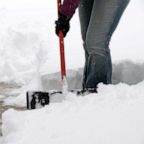Swine Flu Closes Three Schools in NYC
May 15 -- FRIDAY, May 15 (HealthDay News) -- In a troubling sign that the swine flu outbreak has yet to run its current course in the United States, three New York City public schools were closed Thursday after dozens of flu-like infections surfaced and an assistant principal was in critical condition on a ventilator, according to published reports.
Meanwhile, a woman in Arizona who suffered from a lung condition has apparently become the fourth person with swine flu in the United States to die. The Maricopa County Health Department said Thursday that the woman, in her late 40s, died last week of what seemed to be complications from the swine flu, the Associated Press reported.
The three other people in the United States who have died from the infection also had pre-existing health problems.
New York City Mayor Michael Bloomberg said Thursday that four students and the assistant principal at a Queens middle school had diagnosed cases of swine flu. More than 50 students went home sick with flu-like symptoms. At another middle school in Queens, more than 200 students were absent Thursday, and dozens more were sick at an elementary school, The New York Times and the AP reported.
The assistant principal reportedly had underlying health problems before he fell ill. The students who have taken sick in this latest round of infections seem to be experiencing mild symptoms, similar to routine flu, as has been the case for most people in the United States touched by the swine flu.
When the outbreak began more than three weeks ago, hundreds of students and staffers at St. Francis Preparatory School, also in Queens, were sickened. Reports at the time said several St. Francis students had spent spring vacation in Cancun, Mexico. Mexico is believed to be the source of the global outbreak that has now infected more than 7,000 people worldwide.
Also Thursday, vaccine manufacturers and other health experts met at the World Health Organization headquarters in Geneva, Switzerland, to plot potential strategies to combat the swine flu virus.
The AP reported that drug companies were ready to start producing a swine flu vaccine, but many questions remain. They include how many doses to produce, particularly in relation to needed doses of seasonal flu vaccine.
The expert group's recommendations will be forwarded to the WHO's director-general, Margaret Chan, who is expected to issue advice to vaccine manufacturers and the World Health Assembly next week, the AP said.
But at least one infectious-disease expert said it was a "foregone conclusion" that drug manufacturers would be told to proceed with a vaccine for swine flu, technically known as H1N1 flu.
"If we don't invest in an H1N1 (swine flu) vaccine, then possibly we could have a reappearance of this virus in a mild, moderate, or catastrophic form and we would have absolutely nothing," said Dr. David Fedson, a vaccine expert and former professor of medicine at the University of Virginia.
One factor complicating a decision is that most flu vaccine companies can only make limited amounts of both seasonal flu vaccine and pandemic vaccine, such as that needed for swine flu, and not at the same time. The producers also can't make large quantities of both types of vaccine because that would exceed manufacturing capacity, the AP said.
Testing has found that the swine flu virus remains susceptible to two common antiviral drugs, Tamiflu and Relenza, according to the U.S. Centers for Disease Control and Prevention.
On Friday, the CDC was reporting 4,714 U.S. cases of swine flu in 47 states, and four deaths. For the most part, the infections continue to be mild -- similar to seasonal flu -- and recovery is fairly quick.
The World Health Organization on Friday was reporting 7,520 cases in 34 countries.
The swine flu is a highly unusual mix of swine, bird and human flu viruses. Experts worry that, if the new flu virus mutates, people would have limited immunity to fight the infection.
The CDC is concerned with what will happen as this new virus moves into the Southern Hemisphere, where the flu season is about to start. The agency is also preparing for the virus' likely return in the fall to the Northern Hemisphere.
(As of May 15, 2009, 11:00 AM ET)
confirmed and
probable cases




